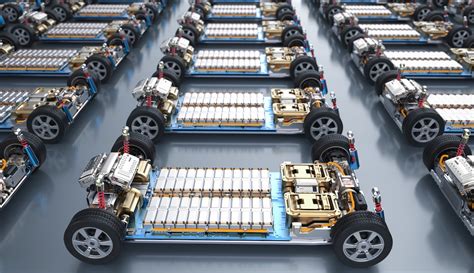
Mounting piles of discarded electric vehicle (EV) batteries pose a significant environmental challenge, but experts are urging against landfill disposal, advocating instead for widespread reuse and recycling to extract valuable materials and extend battery life.
The rapid growth of the electric vehicle market is creating a future surge of spent batteries, estimated to reach thousands of tons annually, prompting concerns about resource management and environmental impact. Instead of burying these batteries, experts like those at Redwood Materials are championing innovative solutions to create a circular economy for battery materials. “We need to build an industry to manage these batteries effectively,” says JB Straubel, Redwood Materials’ CEO, highlighting the urgent need for robust recycling infrastructure.
The Looming Battery Waste Crisis
The transition to electric vehicles is crucial for reducing carbon emissions and combating climate change. However, this shift introduces a new environmental hurdle: what to do with the batteries once they reach the end of their lifespan in vehicles. Lithium-ion batteries, the predominant power source for EVs, contain valuable materials like lithium, nickel, cobalt, and manganese. Landfilling these batteries not only wastes these resources but also poses environmental risks due to potential leakage of harmful chemicals into the soil and groundwater.
As the first generation of EVs begins to reach the end of their usable life, the volume of spent batteries is expected to increase dramatically. Predictions vary, but industry analysts agree that the quantities will be substantial. This surge necessitates proactive strategies for managing this waste stream.
Reuse: Extending Battery Life and Value
Before recycling, experts emphasize the potential for reusing EV batteries in second-life applications. Even after a battery’s performance degrades to the point where it’s no longer suitable for powering a vehicle (typically around 70-80% of its original capacity), it can still be used for less demanding applications such as energy storage systems for homes or businesses.
These second-life applications can significantly extend the useful life of EV batteries and delay the need for recycling. This approach offers both economic and environmental benefits. By repurposing batteries, the demand for new battery production is reduced, which in turn lowers the need for mining and processing raw materials.
Companies are already exploring various second-life applications for EV batteries. For example, some are using them to create grid-scale energy storage systems that can help balance the supply and demand of electricity, especially from renewable energy sources like solar and wind. Others are using them in backup power systems for critical infrastructure or in smaller-scale residential storage systems.
Recycling: Recovering Valuable Materials
When batteries can no longer be reused, recycling becomes essential. Recycling EV batteries allows for the recovery of valuable materials, such as lithium, nickel, cobalt, and manganese. These materials can then be used to manufacture new batteries, creating a closed-loop system and reducing the reliance on virgin materials.
Currently, the recycling infrastructure for EV batteries is still in its early stages of development. However, several companies, including Redwood Materials, are investing heavily in building advanced recycling facilities. These facilities use various technologies to extract the valuable materials from spent batteries.
Redwood Materials, for example, has developed a hydrometallurgical process that can recover over 95% of the battery’s key materials, including lithium, nickel, cobalt, and copper. This process involves dissolving the battery components in a chemical solution and then selectively extracting the desired materials.
The development of efficient and cost-effective recycling technologies is crucial for making battery recycling economically viable. It is also important to establish robust collection and transportation networks to ensure that spent batteries are efficiently routed to recycling facilities.
Challenges and Opportunities
Despite the growing momentum behind reuse and recycling, several challenges remain. One of the biggest challenges is the lack of standardization in battery design. EV batteries come in a variety of shapes, sizes, and chemistries, which makes it difficult to automate the disassembly and recycling processes.
Another challenge is the cost of recycling. Currently, recycling EV batteries can be more expensive than mining new materials. However, as recycling technologies improve and the volume of spent batteries increases, the cost of recycling is expected to decrease. Government policies and incentives can also play a crucial role in making recycling more economically attractive.
Despite these challenges, the opportunities for reuse and recycling of EV batteries are significant. By creating a circular economy for battery materials, we can reduce our reliance on virgin materials, minimize environmental impacts, and create new economic opportunities.
The Role of Policy and Regulation
Government policies and regulations play a critical role in promoting the reuse and recycling of EV batteries. These policies can include mandates for battery recycling, incentives for manufacturers to design batteries that are easier to recycle, and regulations that ensure the safe handling and transportation of spent batteries.
Several countries and regions are already implementing policies to promote battery recycling. The European Union, for example, has established strict regulations on battery recycling, including targets for the recovery of specific materials. The United States is also considering new regulations to promote battery recycling and reduce the environmental impact of battery production.
In addition to government policies, industry standards and certifications can also play a role in promoting responsible battery management. These standards can provide guidelines for the design, testing, and recycling of EV batteries.
Consumer Awareness and Education
Consumer awareness and education are also essential for promoting the reuse and recycling of EV batteries. Consumers need to be informed about the importance of proper battery disposal and the options available for recycling their EV batteries.
Automakers and battery manufacturers can play a role in educating consumers about battery recycling. They can provide information on their websites, in owner’s manuals, and through other communication channels. They can also partner with recycling companies to offer convenient drop-off locations for spent batteries.
By raising consumer awareness and making it easy for consumers to recycle their EV batteries, we can increase the recycling rate and reduce the environmental impact of battery production.
The Future of EV Battery Management
The future of EV battery management is likely to involve a combination of reuse, recycling, and innovative technologies. As the volume of spent batteries increases, we will need to develop more efficient and cost-effective recycling processes. We will also need to find new and innovative ways to reuse EV batteries in second-life applications.
One promising area of research is the development of new battery chemistries that are easier to recycle and contain less toxic materials. For example, some researchers are exploring the use of solid-state batteries, which are more stable and less flammable than traditional lithium-ion batteries. Others are working on developing batteries that use more abundant and less expensive materials, such as sodium or magnesium.
By investing in research and development, we can create a more sustainable and circular economy for EV batteries. This will not only reduce our environmental impact but also create new economic opportunities and ensure that we have the resources we need to power the future of transportation.
Industry Initiatives and Collaborations
Several industry initiatives and collaborations are underway to promote the reuse and recycling of EV batteries. Automakers, battery manufacturers, recycling companies, and research institutions are working together to develop new technologies, establish industry standards, and create sustainable battery management practices.
For example, the Global Battery Alliance is a public-private partnership that brings together stakeholders from across the battery value chain to promote sustainable battery production and use. The alliance is working to develop a common set of principles for responsible battery management and to promote the development of a circular economy for battery materials.
Another example is the Battery Council International, which is a trade association representing the global battery industry. The council is working to promote the responsible recycling of lead-acid batteries and is also exploring opportunities for recycling lithium-ion batteries.
These industry initiatives and collaborations are essential for accelerating the development of sustainable battery management practices and ensuring that we have the resources we need to power the future of transportation.
Economic Considerations
The economic viability of EV battery reuse and recycling is a crucial factor in determining the success of these strategies. While there are environmental benefits to both reuse and recycling, they must also be economically competitive with other options, such as landfill disposal or the use of virgin materials.
The economics of reuse depend on factors such as the cost of refurbishing and repurposing batteries, the market value of second-life applications, and the transportation costs associated with moving batteries to and from reuse facilities. As the volume of spent batteries increases, the economics of reuse are likely to improve, as economies of scale can be achieved.
The economics of recycling depend on factors such as the cost of recycling technologies, the market value of recovered materials, and the collection and transportation costs associated with moving batteries to recycling facilities. As recycling technologies improve and the volume of spent batteries increases, the cost of recycling is expected to decrease.
Government policies and incentives can also play a crucial role in making reuse and recycling more economically attractive. These policies can include tax credits for companies that invest in reuse and recycling infrastructure, subsidies for recycling facilities, and mandates for battery recycling.
Environmental Impact Assessment
A comprehensive environmental impact assessment is essential for evaluating the sustainability of EV battery reuse and recycling strategies. This assessment should consider the environmental impacts of the entire battery lifecycle, from the extraction of raw materials to the end-of-life management of spent batteries.
The environmental impacts of battery production include the energy consumption and greenhouse gas emissions associated with mining and processing raw materials, the water consumption associated with battery manufacturing, and the potential for pollution from battery manufacturing facilities.
The environmental impacts of battery use include the energy consumption and greenhouse gas emissions associated with charging EVs, the potential for battery fires, and the potential for leakage of harmful chemicals from damaged batteries.
The environmental impacts of battery disposal include the potential for pollution from landfills, the loss of valuable materials, and the energy consumption and greenhouse gas emissions associated with transporting batteries to disposal facilities.
By conducting a comprehensive environmental impact assessment, we can identify the most sustainable strategies for managing EV batteries and minimize the environmental impacts of the battery lifecycle.
Technological Advancements
Technological advancements are playing a crucial role in improving the efficiency and cost-effectiveness of EV battery reuse and recycling. New technologies are being developed to automate the disassembly and sorting of batteries, to improve the efficiency of recycling processes, and to find new and innovative ways to reuse EV batteries in second-life applications.
For example, some companies are developing robotic systems to automate the disassembly of EV batteries. These systems can quickly and efficiently disassemble batteries, separating the different components and preparing them for recycling.
Other companies are developing advanced recycling technologies that can recover a higher percentage of the valuable materials from spent batteries. These technologies include hydrometallurgical processes, which use chemical solutions to dissolve and extract the desired materials, and pyrometallurgical processes, which use high temperatures to melt and separate the materials.
In addition, researchers are exploring new and innovative ways to reuse EV batteries in second-life applications. These applications include grid-scale energy storage systems, backup power systems, and residential storage systems.
By investing in technological advancements, we can create a more sustainable and circular economy for EV batteries and ensure that we have the resources we need to power the future of transportation.
Frequently Asked Questions (FAQ)
Q1: Why is it important to reuse and recycle EV batteries instead of burying them?
A: Landfilling EV batteries wastes valuable resources like lithium, nickel, and cobalt, which are essential for manufacturing new batteries. It also poses environmental risks, as harmful chemicals from the batteries can leak into the soil and groundwater, causing pollution. Reusing and recycling reduces the need for mining new materials and minimizes environmental damage.
Q2: What are some potential second-life applications for EV batteries?
A: EV batteries that are no longer suitable for powering vehicles can still be used in less demanding applications, such as energy storage systems for homes, businesses, or the electric grid. They can also be used as backup power sources or in stationary energy storage solutions.
Q3: How are EV batteries currently recycled?
A: EV battery recycling involves disassembling the battery and extracting valuable materials using various technologies, including hydrometallurgical (chemical dissolution) and pyrometallurgical (high-temperature melting) processes. These processes allow for the recovery of lithium, nickel, cobalt, and other metals that can be used to manufacture new batteries.
Q4: What are the main challenges in scaling up EV battery recycling?
A: Key challenges include the lack of standardization in battery design, which makes automated disassembly difficult, the high cost of recycling compared to mining new materials, and the need for a robust collection and transportation infrastructure to efficiently move spent batteries to recycling facilities.
Q5: What role do government policies and regulations play in promoting EV battery reuse and recycling?
A: Government policies can incentivize battery recycling through mandates, tax credits, and subsidies. Regulations can ensure the safe handling and transportation of spent batteries and promote the design of batteries that are easier to recycle. These policies create a framework that makes reuse and recycling more economically viable and environmentally responsible.
Detailed Breakdown and Further Elaboration
The problem of managing end-of-life EV batteries extends far beyond simply finding a place to put them. It represents a complex intersection of environmental concerns, economic opportunities, and technological challenges. Burying these batteries in landfills is not a sustainable solution, as it squanders valuable resources and creates potential environmental hazards. The article correctly highlights the imperative to transition to a circular economy model for EV batteries, where materials are continuously reused and recycled.
Environmental Hazards of Landfilling
Lithium-ion batteries contain a cocktail of materials, some of which are highly toxic and can contaminate the environment if not properly managed. These materials include heavy metals like cobalt and nickel, as well as flammable electrolytes. When batteries degrade in a landfill, these substances can leach into the surrounding soil and groundwater, potentially polluting water sources and harming ecosystems. Furthermore, the decomposition of organic materials within the battery can generate greenhouse gases, contributing to climate change.
The Value of Recovered Materials
EV batteries contain significant amounts of valuable materials that can be recovered and reused. Lithium, nickel, cobalt, and manganese are all critical components of new batteries, and recycling them reduces the need to mine these materials from the earth. Mining operations can have significant environmental impacts, including habitat destruction, water pollution, and greenhouse gas emissions. By recycling EV batteries, we can reduce our reliance on mining and minimize these environmental impacts.
Second-Life Applications: Extending Battery Lifespan
Before recycling, EV batteries can often be repurposed for second-life applications. Even when a battery’s capacity has degraded to the point where it’s no longer suitable for powering a vehicle, it can still be used for less demanding applications, such as energy storage systems. These systems can be used to store energy from renewable sources like solar and wind, providing a reliable and sustainable source of power. Second-life applications not only extend the lifespan of EV batteries but also reduce the demand for new battery production, further minimizing environmental impacts.
Recycling Technologies: Extracting Valuable Materials
Several different technologies are used to recycle EV batteries. Hydrometallurgical processes involve dissolving the battery components in a chemical solution and then selectively extracting the desired materials. Pyrometallurgical processes involve heating the batteries to high temperatures to melt and separate the materials. Both of these technologies have their advantages and disadvantages, and the best approach depends on the specific battery chemistry and the desired materials to be recovered.
Challenges to Scaling Up Recycling Infrastructure
Despite the potential benefits of recycling EV batteries, several challenges remain. One of the biggest challenges is the lack of standardization in battery design. EV batteries come in a variety of shapes, sizes, and chemistries, which makes it difficult to automate the disassembly and recycling processes. Another challenge is the cost of recycling. Currently, recycling EV batteries can be more expensive than mining new materials. However, as recycling technologies improve and the volume of spent batteries increases, the cost of recycling is expected to decrease.
The Role of Government Policy
Government policies can play a crucial role in promoting the reuse and recycling of EV batteries. Policies can include mandates for battery recycling, incentives for manufacturers to design batteries that are easier to recycle, and regulations that ensure the safe handling and transportation of spent batteries. These policies can help to create a level playing field for recycling and ensure that it is economically viable.
Industry Initiatives and Collaboration
In addition to government policies, industry initiatives and collaboration are also essential for promoting the reuse and recycling of EV batteries. Automakers, battery manufacturers, recycling companies, and research institutions are working together to develop new technologies, establish industry standards, and create sustainable battery management practices. These collaborations can help to accelerate the development of a circular economy for EV batteries.
Consumer Awareness and Education
Consumer awareness and education are also essential for promoting the reuse and recycling of EV batteries. Consumers need to be informed about the importance of proper battery disposal and the options available for recycling their EV batteries. Automakers and battery manufacturers can play a role in educating consumers about battery recycling. They can provide information on their websites, in owner’s manuals, and through other communication channels. They can also partner with recycling companies to offer convenient drop-off locations for spent batteries.
Looking Ahead: A Sustainable Future for EV Batteries
The future of EV battery management will require a multifaceted approach that includes reuse, recycling, and technological innovation. By working together, governments, industries, and consumers can create a sustainable future for EV batteries, reducing environmental impacts and ensuring the responsible use of valuable resources. This also involves continued research into new battery chemistries that are more sustainable and easier to recycle. Solid-state batteries, for example, are emerging as a promising alternative to traditional lithium-ion batteries, offering improved safety and recyclability. The development of battery passports, which track the materials and history of a battery throughout its lifecycle, can also facilitate reuse and recycling efforts.
The Economic Impact of a Circular Battery Economy
The transition to a circular battery economy will not only benefit the environment but also create new economic opportunities. The recycling industry is poised for significant growth as the volume of spent EV batteries increases. This growth will create new jobs in areas such as battery disassembly, materials recovery, and battery remanufacturing. The availability of recycled materials will also reduce the dependence on imported raw materials, strengthening domestic supply chains and reducing vulnerability to price fluctuations.
Addressing Concerns About Battery Safety
Safety is a paramount concern when handling and recycling EV batteries. Damaged or improperly handled batteries can pose a fire risk. Therefore, it is essential to have strict safety protocols in place at recycling facilities and during the transportation of spent batteries. These protocols should include measures to prevent short circuits, control temperature, and suppress fires. Furthermore, workers handling batteries should be properly trained and equipped with appropriate protective gear. The development of automated disassembly systems can also help to reduce the risk of human error and improve safety.
The Importance of Standardization
Standardization is critical for improving the efficiency and cost-effectiveness of EV battery recycling. Standardized battery designs would allow for automated disassembly and sorting, reducing labor costs and improving the recovery of valuable materials. Standardized recycling processes would also ensure consistent quality and environmental performance. Governments and industry organizations should work together to develop and implement standards for EV battery design and recycling.
Global Perspectives on Battery Recycling
The challenge of managing end-of-life EV batteries is a global one, and different countries and regions are adopting different approaches. The European Union has taken a leading role in promoting battery recycling through its strict regulations and targets for materials recovery. Other countries, such as China and the United States, are also developing policies and regulations to promote battery recycling. It is important for countries to share best practices and collaborate on research and development to accelerate the transition to a circular battery economy.
The Future of Battery Technology
The future of battery technology will have a significant impact on the sustainability of the EV industry. New battery chemistries, such as solid-state batteries and sodium-ion batteries, offer the potential for improved performance, safety, and recyclability. These new technologies could also reduce the reliance on scarce and expensive materials like cobalt and lithium. Continued investment in battery research and development is essential for creating a more sustainable future for EV batteries.
Conclusion
The responsible management of EV batteries is a critical challenge that must be addressed to ensure the long-term sustainability of the electric vehicle revolution. By prioritizing reuse and recycling over landfill disposal, we can conserve valuable resources, minimize environmental impacts, and create new economic opportunities. Government policies, industry initiatives, consumer awareness, and technological innovation all play essential roles in achieving a circular economy for EV batteries. By working together, we can create a future where EV batteries are not seen as waste but as valuable resources that can be used again and again. The development and implementation of robust tracking systems, such as battery passports, will also be crucial for ensuring transparency and accountability throughout the battery lifecycle. The collaboration between automakers, battery manufacturers, recyclers, and policymakers will be essential for creating a sustainable and circular battery economy that benefits both the environment and the economy.









